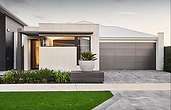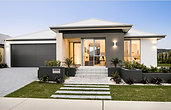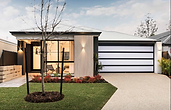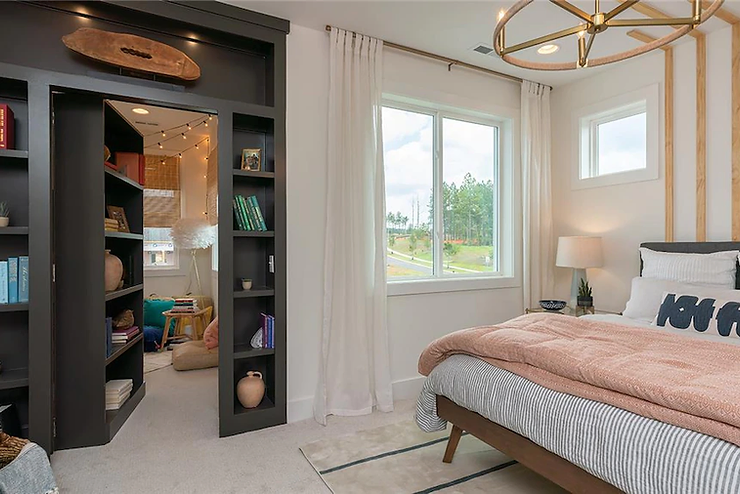Post Covid home design. New ideas?
“The Barnaby” might be a strange name for a home of the future, but that’s what this four-bedroom demonstration house claims to be. Located in a small town in South Carolina, it’s the size of an average new house in Australia and looks pretty normal from the outside. Inside, the differences are obvious: a front-door “vestibule” for no-contact home delivery, two “pocket” home offices (neither of which is a bedroom), a school room, a quarantine room, a “secret room” behind a bookcase (for being alone), and a whopping four bathrooms.
A secret room hidden behind a book case in The Barnaby demonstration house.(Supplied: Dahlin Group)
In case you haven’t guessed it yet, this is a design shaped by the pandemic. The team of architects, social researchers, and marketing experts that dreamed it up say every detail is informed by insights from a survey into the impact of COVID on homes and communities in America. What about in Australia? Here, the property industry is seeing demand for features like those of The Barnaby (though not four bathrooms). The dedicated home office is king, and there’s generally greater appreciation for good design and quality of construction.
COVID shone a light on all the pre-existing problems with our housing and asked us to do more with our houses, including working from home (WFH). So, what does an ideal post-COVID Australian home look like? And will any actually get built?
Enter the ‘flex space’
The Barnaby’s design choices were informed by the America at Home study, which surveyed more than 6,000 US adults in 2020.
It found that Millennials and Gen Xers wanted relatively uncommon features such as germ-resistant countertops and flooring, greater energy efficiency, more storage for food or water, touch-free taps, appliances and toilets, and space for more than one home office. “Post-pandemic, people have realised their homes can do more and that better design matters,” said Nancy Keenan, president and chief executive officer of Dahlin Group Architecture Planning, the California-based firm that helped design The Barnaby demonstration house. Key to making a home do more is something called “the flex space”, or a room with multiple potential uses. What this boils down to is an open-plan living room and kitchen, and then lots of “acoustically secure” (ie. decently soundproofed) medium-sized rooms that could be home offices, bedrooms, media rooms, and the like.
The Barnaby’s two dedicated office spaces are on separate levels, to minimise disruption. Along with this, there’s a scattering of tiny “pocket flex spaces” that could be used as smaller studies or walk-in wardrobes.
The idea is that a whole family (The Barnaby was designed for a Millennial couple with two young children, where one parent works from home) can use the one house for lots of different things, all at the same time. “Providing spaces in the home that can be used in many ways is key to a successful floor plan, especially when designing to smaller square footages,” Ms Keenan said. “Our clients are also exploring the viability of optioning flexible furniture systems and moveable walls to enhance space flexibility.”
From study nook to home office
These trends can be seen in Australia. Every two years, property developer Mirvac surveys customers about what they’re looking for in a house or an apartment. The most recent survey showed a clear shift in thinking, said Diana Sarcasmo, head of design at Mirvac, which has $26 billion worth of assets under management in Sydney, Melbourne, Brisbane and Perth. “Half the people we spoke to in the survey said they were looking for a hybrid working arrangement going forward,” Ms Sarcasmo said.
That change is reflected in demand for home offices.
“There’s been a 20 per cent increase in people in apartments asking for a study. And in housing, there’s double the number.”
The surge in pet ownership during lockdowns means people are willing to pay extra for doggy doors and dog-wash facilities. And hours spent WFH has made people aware of “sustainability upgrades” like thermal insulation. “People have always wanted sustainability upgrades, but weren’t willing to pay for them,” Ms Sarcasmo said. “Now 64 per cent say they’re willing to pay extra. That’s a massive shift over the last couple of years.” George Massoud, design director at Frasers Property, another large developer, agreed. He’s also seen people placing greater value on “things like quality of light, ventilation, and acoustics”. And the home office with a door you can close is here to stay.
“The mediocre study nook doesn’t cut it anymore.”
Todays Good Reads
Perth’s own master of the shoey.
Everyone’s favourite smiling assassin talks post race rituals.
Sign of the times
Perth’s top critic loses his platform.
The Great Southern’s underrated jewell
Looking for a getaway without breaking the bank? Say hi to Esperance.

Are weekends too short?
With the WA Day three-day weekend coming up, it is worth reassessing the amount of time we devote to work. What if all weekends could last for three or even four days? What if the majority of the week could be given over to activities other than work? What if most of our time could be devoted to non-work activities of our own choosing?
To even pose these questions is to invite the criticism of Utopian thinking. While a fine idea in principle, working fewer hours is not feasible in practice. Indeed, its achievement would come at the expense of lower consumption and increased economic hardship.
For some advocates of the work ethic, the route to health and happiness lies with the perpetuation of work, not with its reduction. Work makes us healthier and happier. Such pro-work ideology is used to legitimate welfare reforms that seek to coerce the non-employed into work, whatever its rates of pay and qualitative features. It also offers an ideological barrier to the case for spending less time at work. Working less is presented as a threat to our health and happiness, not a means to improve it.
Yet, the idea of working less is not only feasible, it is also the basis for a better standard of life. It is a mark of how we have come to accept work and its dominant influence in our lives that we do not grasp this idea more readily.
The costs of working more
A growing number of studies show the human costs of longer working hours. These include lower physical and mental health. Working long hours can add to the risk of having a stroke, coronary heart disease and developing type 2 diabetes.
By working most of the time, we also lose time with family and friends. And more than this we lose the ability to be and do things that make life valuable and worth living. Our lives are often too much tied up in the work we do that we have little time and energy to find alternative ways of living – in short, our capacity to realise our talents and potential is curtailed by the work we do. Work does not set us free, rather it hems us in and makes it more difficult to realise ourselves.
Content with more content
Now if you prefer to consume your information through audio instead of through text (which is understandable) come and check out or podcast which lives here. It is a show we are doing weekly which has a nice blend of education and entertainment aimed at the prospective homebuyer.





